Major Essay 1: Cultural Stereotypes, Appearance, and Society's Impact
VerifiedAdded on 2023/04/07
|11
|2508
|428
Essay
AI Summary
This essay delves into the pervasive issue of cultural stereotypes and their detrimental effects on individuals and society, focusing specifically on appearance-based discrimination. The author examines how societal pressures and evolutionary conditioning contribute to the prioritization of physical attractiveness, leading to various forms of bias in areas like employment, social interactions, and even legal outcomes. The essay explores the concept of the "beauty is good" generalization and its influence on perceptions of competence and character. It further analyzes how gender roles and societal expectations shape standards of beauty and lead to biases, particularly in the workplace. The essay also investigates the role of social media and cultural trends in exacerbating these stereotypes, leading to issues such as cyberbullying and mental health concerns. The author argues for increased awareness, education, and the promotion of individual self-expression as potential solutions to mitigate the negative consequences of appearance-based prejudice and discrimination. The essay concludes by advocating for programs that promote awareness and education in order to challenge the harmful cultural trends and encourage individuals to embrace their true physical qualities regardless of cultural stereotypes.
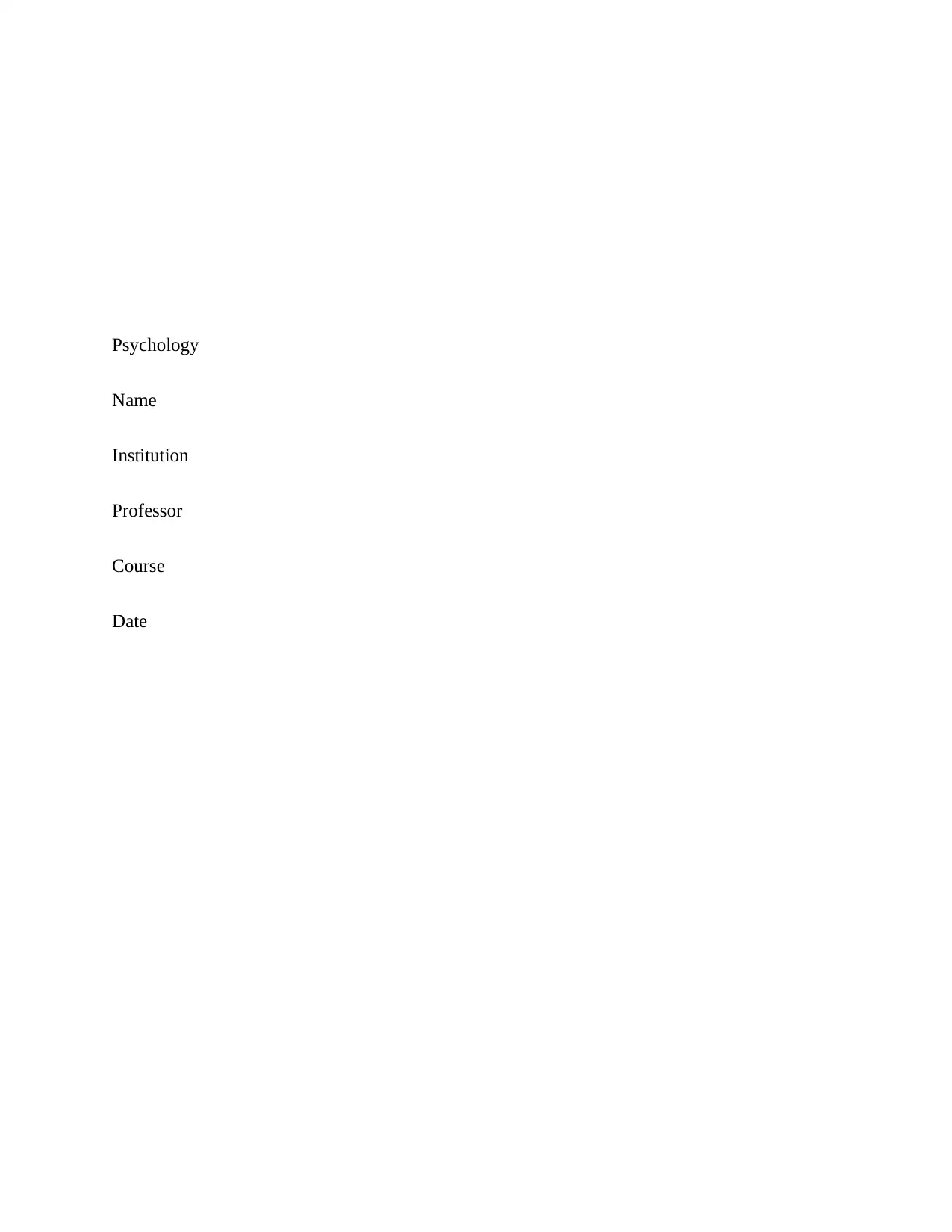
Psychology
Name
Institution
Professor
Course
Date
Name
Institution
Professor
Course
Date
Paraphrase This Document
Need a fresh take? Get an instant paraphrase of this document with our AI Paraphraser
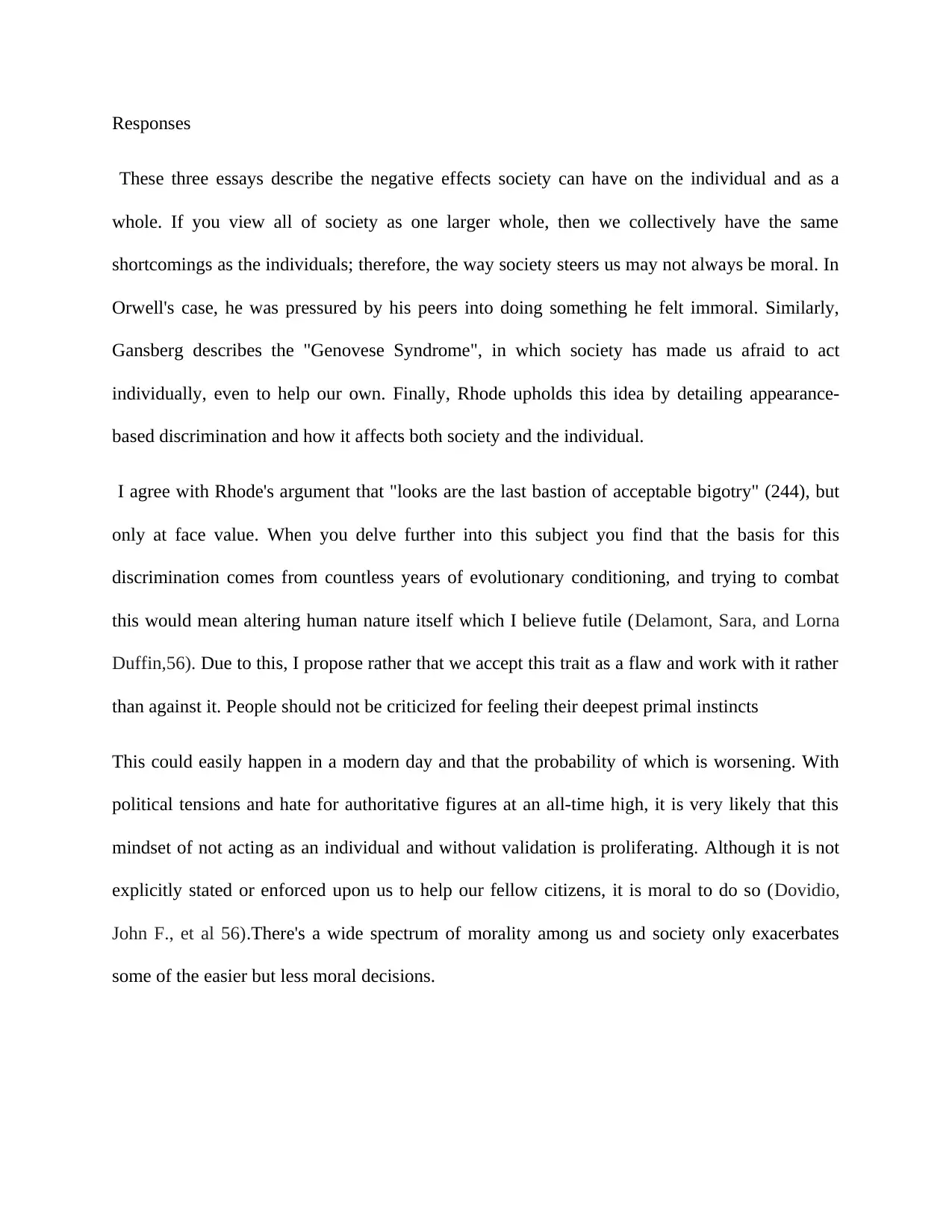
Responses
These three essays describe the negative effects society can have on the individual and as a
whole. If you view all of society as one larger whole, then we collectively have the same
shortcomings as the individuals; therefore, the way society steers us may not always be moral. In
Orwell's case, he was pressured by his peers into doing something he felt immoral. Similarly,
Gansberg describes the "Genovese Syndrome", in which society has made us afraid to act
individually, even to help our own. Finally, Rhode upholds this idea by detailing appearance-
based discrimination and how it affects both society and the individual.
I agree with Rhode's argument that "looks are the last bastion of acceptable bigotry" (244), but
only at face value. When you delve further into this subject you find that the basis for this
discrimination comes from countless years of evolutionary conditioning, and trying to combat
this would mean altering human nature itself which I believe futile (Delamont, Sara, and Lorna
Duffin,56). Due to this, I propose rather that we accept this trait as a flaw and work with it rather
than against it. People should not be criticized for feeling their deepest primal instincts
This could easily happen in a modern day and that the probability of which is worsening. With
political tensions and hate for authoritative figures at an all-time high, it is very likely that this
mindset of not acting as an individual and without validation is proliferating. Although it is not
explicitly stated or enforced upon us to help our fellow citizens, it is moral to do so (Dovidio,
John F., et al 56).There's a wide spectrum of morality among us and society only exacerbates
some of the easier but less moral decisions.
These three essays describe the negative effects society can have on the individual and as a
whole. If you view all of society as one larger whole, then we collectively have the same
shortcomings as the individuals; therefore, the way society steers us may not always be moral. In
Orwell's case, he was pressured by his peers into doing something he felt immoral. Similarly,
Gansberg describes the "Genovese Syndrome", in which society has made us afraid to act
individually, even to help our own. Finally, Rhode upholds this idea by detailing appearance-
based discrimination and how it affects both society and the individual.
I agree with Rhode's argument that "looks are the last bastion of acceptable bigotry" (244), but
only at face value. When you delve further into this subject you find that the basis for this
discrimination comes from countless years of evolutionary conditioning, and trying to combat
this would mean altering human nature itself which I believe futile (Delamont, Sara, and Lorna
Duffin,56). Due to this, I propose rather that we accept this trait as a flaw and work with it rather
than against it. People should not be criticized for feeling their deepest primal instincts
This could easily happen in a modern day and that the probability of which is worsening. With
political tensions and hate for authoritative figures at an all-time high, it is very likely that this
mindset of not acting as an individual and without validation is proliferating. Although it is not
explicitly stated or enforced upon us to help our fellow citizens, it is moral to do so (Dovidio,
John F., et al 56).There's a wide spectrum of morality among us and society only exacerbates
some of the easier but less moral decisions.
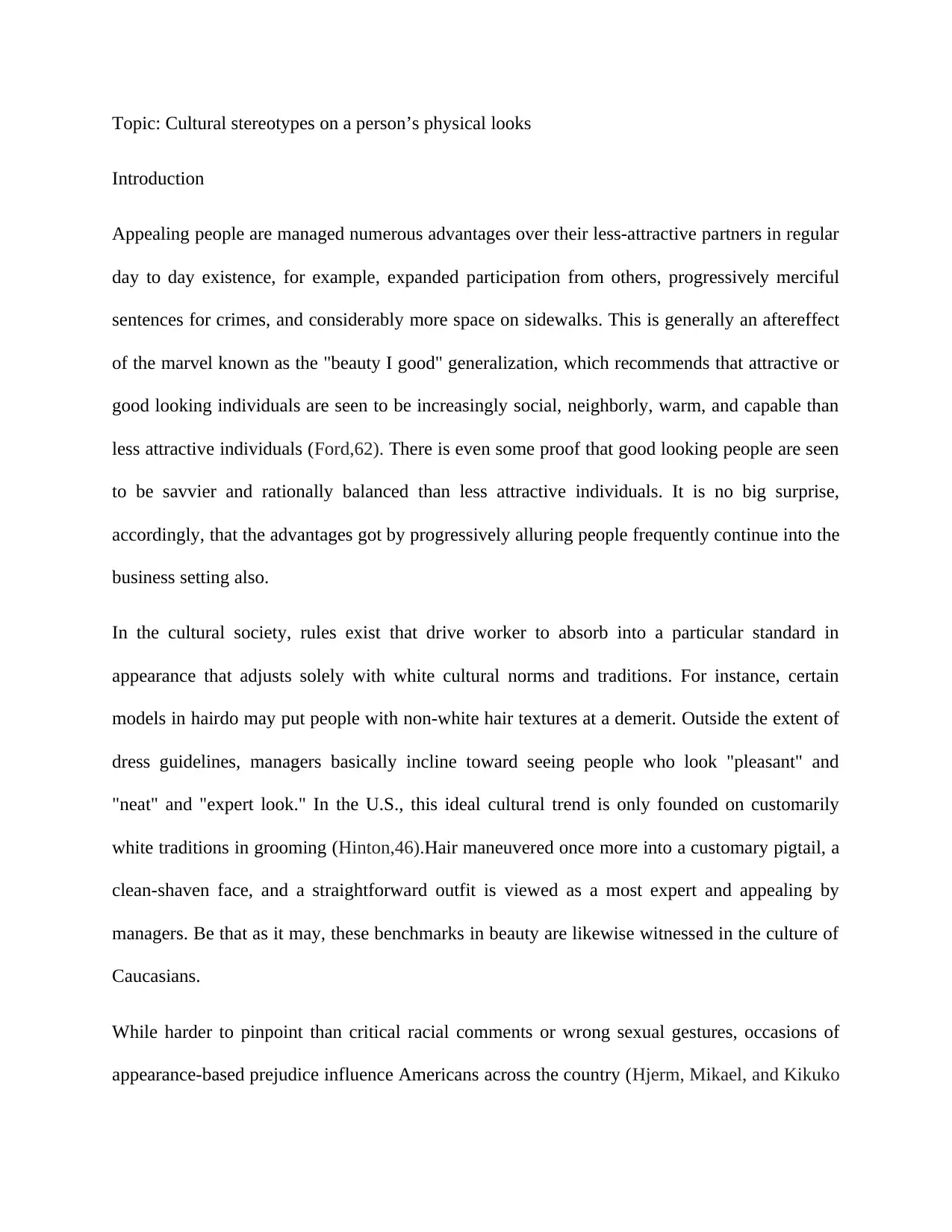
Topic: Cultural stereotypes on a person’s physical looks
Introduction
Appealing people are managed numerous advantages over their less-attractive partners in regular
day to day existence, for example, expanded participation from others, progressively merciful
sentences for crimes, and considerably more space on sidewalks. This is generally an aftereffect
of the marvel known as the "beauty I good" generalization, which recommends that attractive or
good looking individuals are seen to be increasingly social, neighborly, warm, and capable than
less attractive individuals (Ford,62). There is even some proof that good looking people are seen
to be savvier and rationally balanced than less attractive individuals. It is no big surprise,
accordingly, that the advantages got by progressively alluring people frequently continue into the
business setting also.
In the cultural society, rules exist that drive worker to absorb into a particular standard in
appearance that adjusts solely with white cultural norms and traditions. For instance, certain
models in hairdo may put people with non-white hair textures at a demerit. Outside the extent of
dress guidelines, managers basically incline toward seeing people who look "pleasant" and
"neat" and "expert look." In the U.S., this ideal cultural trend is only founded on customarily
white traditions in grooming (Hinton,46).Hair maneuvered once more into a customary pigtail, a
clean-shaven face, and a straightforward outfit is viewed as a most expert and appealing by
managers. Be that as it may, these benchmarks in beauty are likewise witnessed in the culture of
Caucasians.
While harder to pinpoint than critical racial comments or wrong sexual gestures, occasions of
appearance-based prejudice influence Americans across the country (Hjerm, Mikael, and Kikuko
Introduction
Appealing people are managed numerous advantages over their less-attractive partners in regular
day to day existence, for example, expanded participation from others, progressively merciful
sentences for crimes, and considerably more space on sidewalks. This is generally an aftereffect
of the marvel known as the "beauty I good" generalization, which recommends that attractive or
good looking individuals are seen to be increasingly social, neighborly, warm, and capable than
less attractive individuals (Ford,62). There is even some proof that good looking people are seen
to be savvier and rationally balanced than less attractive individuals. It is no big surprise,
accordingly, that the advantages got by progressively alluring people frequently continue into the
business setting also.
In the cultural society, rules exist that drive worker to absorb into a particular standard in
appearance that adjusts solely with white cultural norms and traditions. For instance, certain
models in hairdo may put people with non-white hair textures at a demerit. Outside the extent of
dress guidelines, managers basically incline toward seeing people who look "pleasant" and
"neat" and "expert look." In the U.S., this ideal cultural trend is only founded on customarily
white traditions in grooming (Hinton,46).Hair maneuvered once more into a customary pigtail, a
clean-shaven face, and a straightforward outfit is viewed as a most expert and appealing by
managers. Be that as it may, these benchmarks in beauty are likewise witnessed in the culture of
Caucasians.
While harder to pinpoint than critical racial comments or wrong sexual gestures, occasions of
appearance-based prejudice influence Americans across the country (Hjerm, Mikael, and Kikuko
⊘ This is a preview!⊘
Do you want full access?
Subscribe today to unlock all pages.

Trusted by 1+ million students worldwide
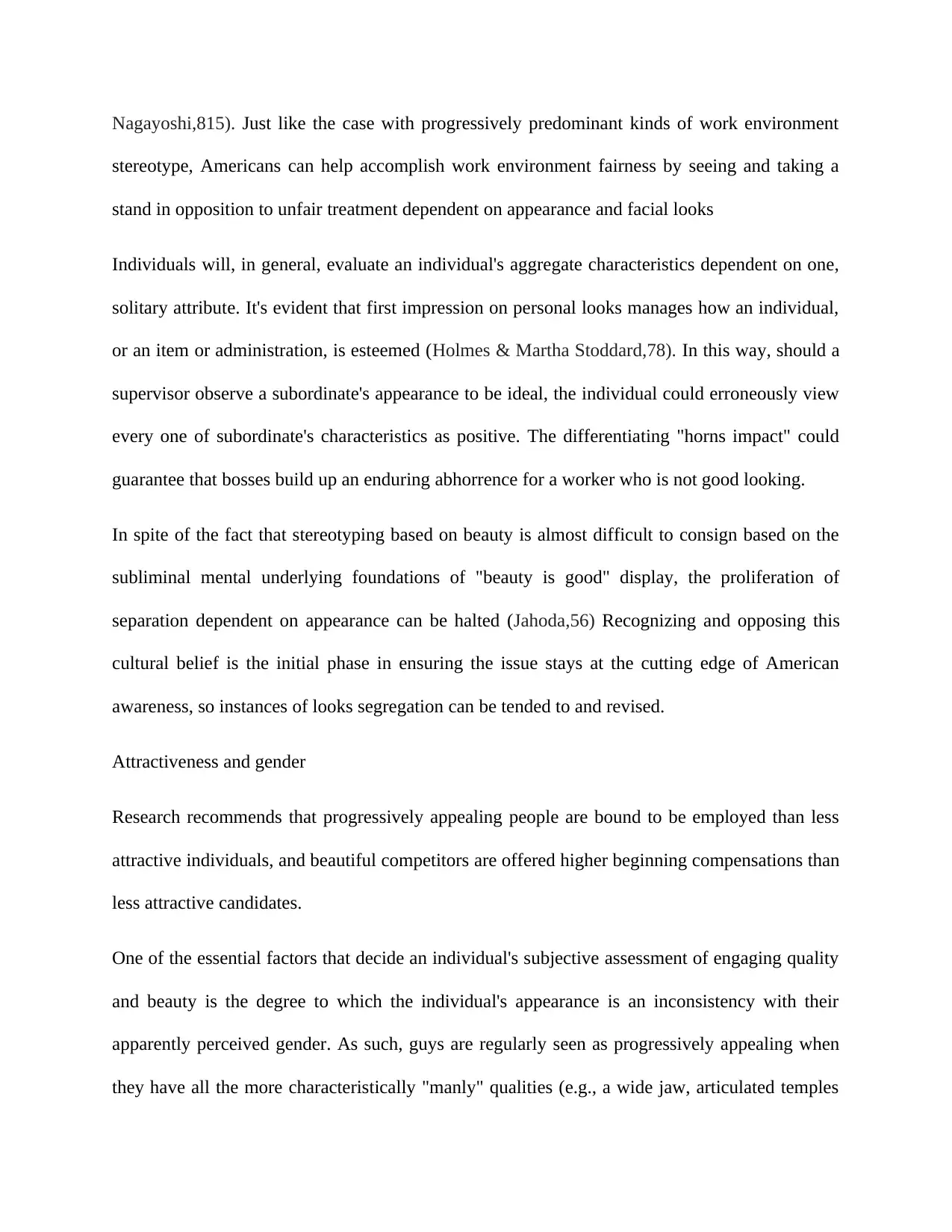
Nagayoshi,815). Just like the case with progressively predominant kinds of work environment
stereotype, Americans can help accomplish work environment fairness by seeing and taking a
stand in opposition to unfair treatment dependent on appearance and facial looks
Individuals will, in general, evaluate an individual's aggregate characteristics dependent on one,
solitary attribute. It's evident that first impression on personal looks manages how an individual,
or an item or administration, is esteemed (Holmes & Martha Stoddard,78). In this way, should a
supervisor observe a subordinate's appearance to be ideal, the individual could erroneously view
every one of subordinate's characteristics as positive. The differentiating "horns impact" could
guarantee that bosses build up an enduring abhorrence for a worker who is not good looking.
In spite of the fact that stereotyping based on beauty is almost difficult to consign based on the
subliminal mental underlying foundations of "beauty is good" display, the proliferation of
separation dependent on appearance can be halted (Jahoda,56) Recognizing and opposing this
cultural belief is the initial phase in ensuring the issue stays at the cutting edge of American
awareness, so instances of looks segregation can be tended to and revised.
Attractiveness and gender
Research recommends that progressively appealing people are bound to be employed than less
attractive individuals, and beautiful competitors are offered higher beginning compensations than
less attractive candidates.
One of the essential factors that decide an individual's subjective assessment of engaging quality
and beauty is the degree to which the individual's appearance is an inconsistency with their
apparently perceived gender. As such, guys are regularly seen as progressively appealing when
they have all the more characteristically "manly" qualities (e.g., a wide jaw, articulated temples
stereotype, Americans can help accomplish work environment fairness by seeing and taking a
stand in opposition to unfair treatment dependent on appearance and facial looks
Individuals will, in general, evaluate an individual's aggregate characteristics dependent on one,
solitary attribute. It's evident that first impression on personal looks manages how an individual,
or an item or administration, is esteemed (Holmes & Martha Stoddard,78). In this way, should a
supervisor observe a subordinate's appearance to be ideal, the individual could erroneously view
every one of subordinate's characteristics as positive. The differentiating "horns impact" could
guarantee that bosses build up an enduring abhorrence for a worker who is not good looking.
In spite of the fact that stereotyping based on beauty is almost difficult to consign based on the
subliminal mental underlying foundations of "beauty is good" display, the proliferation of
separation dependent on appearance can be halted (Jahoda,56) Recognizing and opposing this
cultural belief is the initial phase in ensuring the issue stays at the cutting edge of American
awareness, so instances of looks segregation can be tended to and revised.
Attractiveness and gender
Research recommends that progressively appealing people are bound to be employed than less
attractive individuals, and beautiful competitors are offered higher beginning compensations than
less attractive candidates.
One of the essential factors that decide an individual's subjective assessment of engaging quality
and beauty is the degree to which the individual's appearance is an inconsistency with their
apparently perceived gender. As such, guys are regularly seen as progressively appealing when
they have all the more characteristically "manly" qualities (e.g., a wide jaw, articulated temples
Paraphrase This Document
Need a fresh take? Get an instant paraphrase of this document with our AI Paraphraser
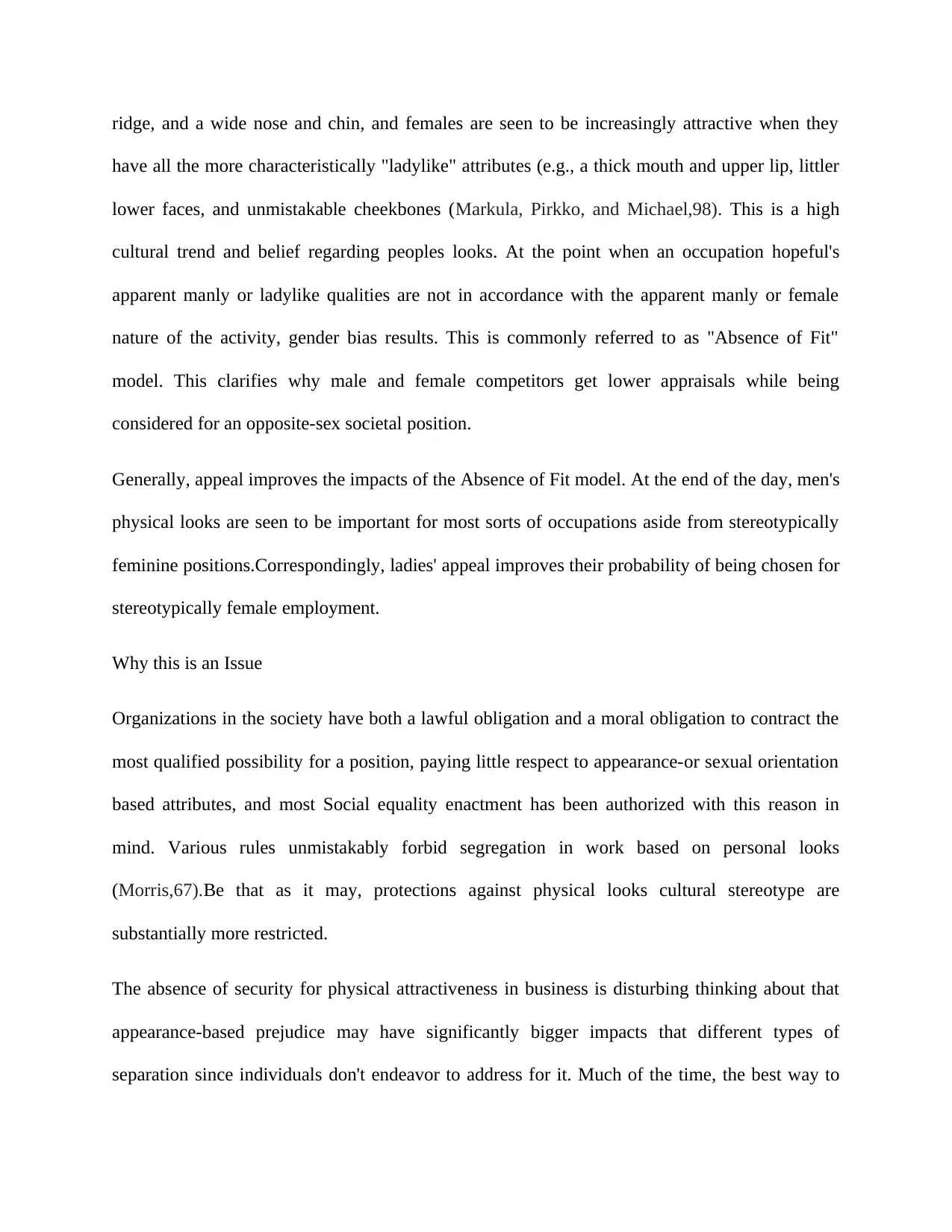
ridge, and a wide nose and chin, and females are seen to be increasingly attractive when they
have all the more characteristically "ladylike" attributes (e.g., a thick mouth and upper lip, littler
lower faces, and unmistakable cheekbones (Markula, Pirkko, and Michael,98). This is a high
cultural trend and belief regarding peoples looks. At the point when an occupation hopeful's
apparent manly or ladylike qualities are not in accordance with the apparent manly or female
nature of the activity, gender bias results. This is commonly referred to as "Absence of Fit"
model. This clarifies why male and female competitors get lower appraisals while being
considered for an opposite-sex societal position.
Generally, appeal improves the impacts of the Absence of Fit model. At the end of the day, men's
physical looks are seen to be important for most sorts of occupations aside from stereotypically
feminine positions.Correspondingly, ladies' appeal improves their probability of being chosen for
stereotypically female employment.
Why this is an Issue
Organizations in the society have both a lawful obligation and a moral obligation to contract the
most qualified possibility for a position, paying little respect to appearance-or sexual orientation
based attributes, and most Social equality enactment has been authorized with this reason in
mind. Various rules unmistakably forbid segregation in work based on personal looks
(Morris,67).Be that as it may, protections against physical looks cultural stereotype are
substantially more restricted.
The absence of security for physical attractiveness in business is disturbing thinking about that
appearance-based prejudice may have significantly bigger impacts that different types of
separation since individuals don't endeavor to address for it. Much of the time, the best way to
have all the more characteristically "ladylike" attributes (e.g., a thick mouth and upper lip, littler
lower faces, and unmistakable cheekbones (Markula, Pirkko, and Michael,98). This is a high
cultural trend and belief regarding peoples looks. At the point when an occupation hopeful's
apparent manly or ladylike qualities are not in accordance with the apparent manly or female
nature of the activity, gender bias results. This is commonly referred to as "Absence of Fit"
model. This clarifies why male and female competitors get lower appraisals while being
considered for an opposite-sex societal position.
Generally, appeal improves the impacts of the Absence of Fit model. At the end of the day, men's
physical looks are seen to be important for most sorts of occupations aside from stereotypically
feminine positions.Correspondingly, ladies' appeal improves their probability of being chosen for
stereotypically female employment.
Why this is an Issue
Organizations in the society have both a lawful obligation and a moral obligation to contract the
most qualified possibility for a position, paying little respect to appearance-or sexual orientation
based attributes, and most Social equality enactment has been authorized with this reason in
mind. Various rules unmistakably forbid segregation in work based on personal looks
(Morris,67).Be that as it may, protections against physical looks cultural stereotype are
substantially more restricted.
The absence of security for physical attractiveness in business is disturbing thinking about that
appearance-based prejudice may have significantly bigger impacts that different types of
separation since individuals don't endeavor to address for it. Much of the time, the best way to
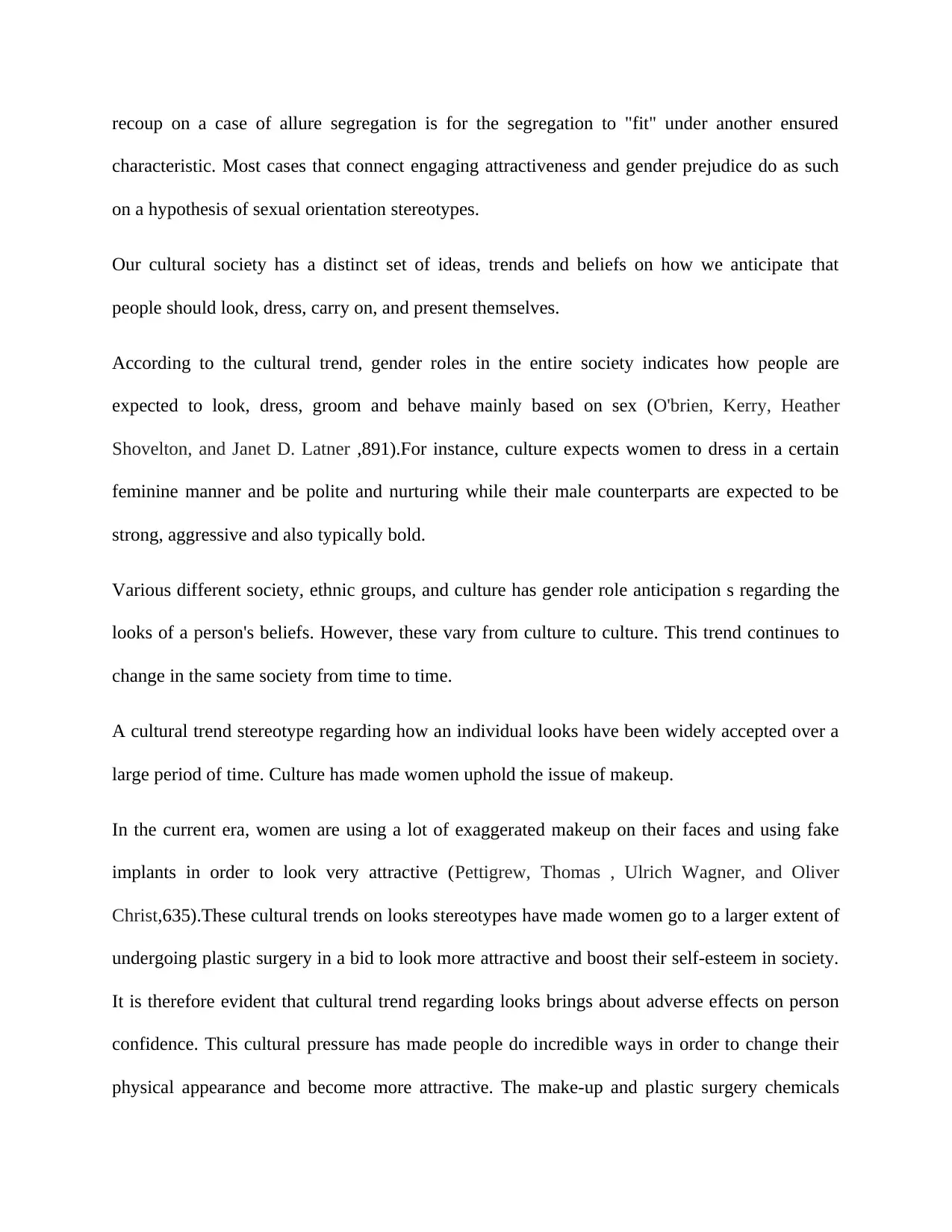
recoup on a case of allure segregation is for the segregation to "fit" under another ensured
characteristic. Most cases that connect engaging attractiveness and gender prejudice do as such
on a hypothesis of sexual orientation stereotypes.
Our cultural society has a distinct set of ideas, trends and beliefs on how we anticipate that
people should look, dress, carry on, and present themselves.
According to the cultural trend, gender roles in the entire society indicates how people are
expected to look, dress, groom and behave mainly based on sex (O'brien, Kerry, Heather
Shovelton, and Janet D. Latner ,891).For instance, culture expects women to dress in a certain
feminine manner and be polite and nurturing while their male counterparts are expected to be
strong, aggressive and also typically bold.
Various different society, ethnic groups, and culture has gender role anticipation s regarding the
looks of a person's beliefs. However, these vary from culture to culture. This trend continues to
change in the same society from time to time.
A cultural trend stereotype regarding how an individual looks have been widely accepted over a
large period of time. Culture has made women uphold the issue of makeup.
In the current era, women are using a lot of exaggerated makeup on their faces and using fake
implants in order to look very attractive (Pettigrew, Thomas , Ulrich Wagner, and Oliver
Christ,635).These cultural trends on looks stereotypes have made women go to a larger extent of
undergoing plastic surgery in a bid to look more attractive and boost their self-esteem in society.
It is therefore evident that cultural trend regarding looks brings about adverse effects on person
confidence. This cultural pressure has made people do incredible ways in order to change their
physical appearance and become more attractive. The make-up and plastic surgery chemicals
characteristic. Most cases that connect engaging attractiveness and gender prejudice do as such
on a hypothesis of sexual orientation stereotypes.
Our cultural society has a distinct set of ideas, trends and beliefs on how we anticipate that
people should look, dress, carry on, and present themselves.
According to the cultural trend, gender roles in the entire society indicates how people are
expected to look, dress, groom and behave mainly based on sex (O'brien, Kerry, Heather
Shovelton, and Janet D. Latner ,891).For instance, culture expects women to dress in a certain
feminine manner and be polite and nurturing while their male counterparts are expected to be
strong, aggressive and also typically bold.
Various different society, ethnic groups, and culture has gender role anticipation s regarding the
looks of a person's beliefs. However, these vary from culture to culture. This trend continues to
change in the same society from time to time.
A cultural trend stereotype regarding how an individual looks have been widely accepted over a
large period of time. Culture has made women uphold the issue of makeup.
In the current era, women are using a lot of exaggerated makeup on their faces and using fake
implants in order to look very attractive (Pettigrew, Thomas , Ulrich Wagner, and Oliver
Christ,635).These cultural trends on looks stereotypes have made women go to a larger extent of
undergoing plastic surgery in a bid to look more attractive and boost their self-esteem in society.
It is therefore evident that cultural trend regarding looks brings about adverse effects on person
confidence. This cultural pressure has made people do incredible ways in order to change their
physical appearance and become more attractive. The make-up and plastic surgery chemicals
⊘ This is a preview!⊘
Do you want full access?
Subscribe today to unlock all pages.

Trusted by 1+ million students worldwide
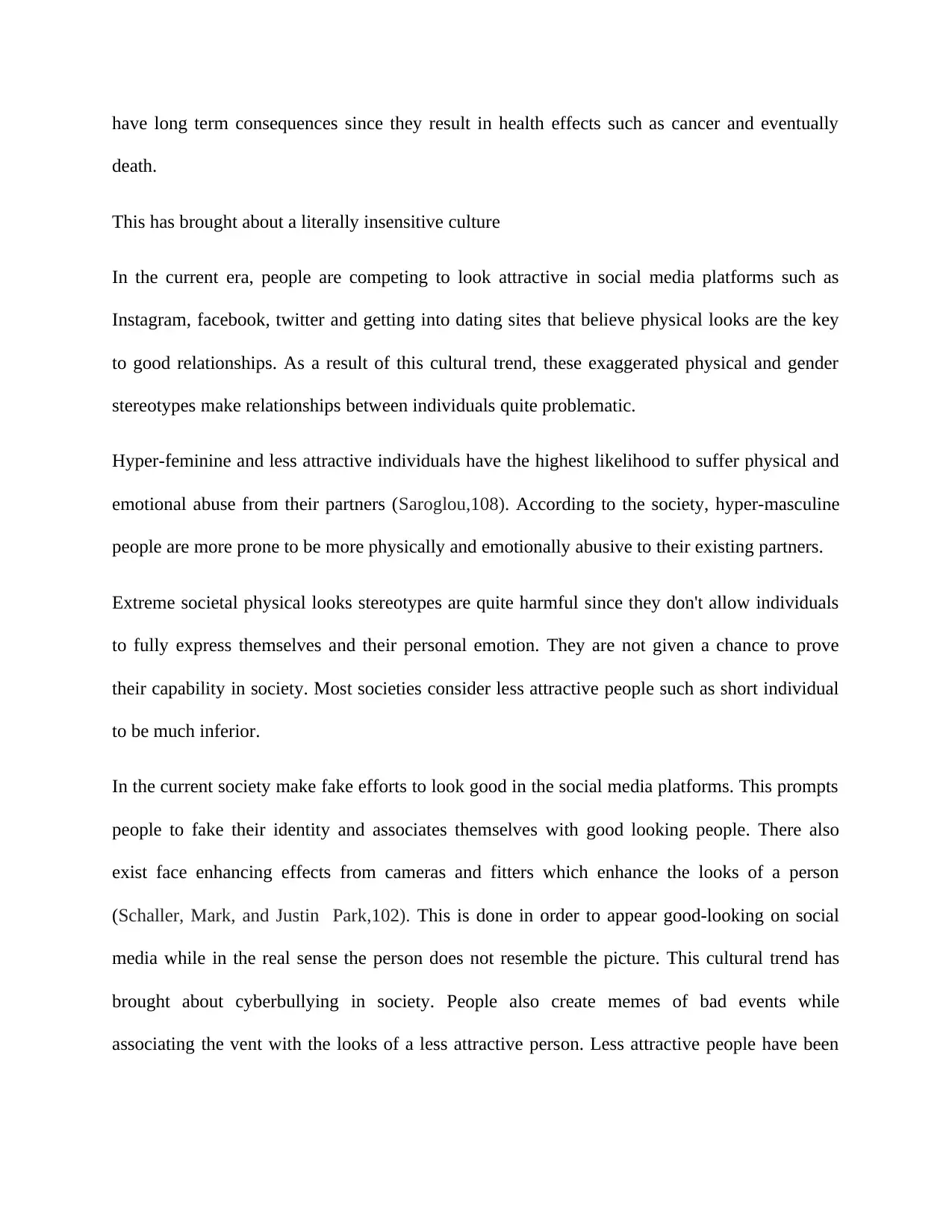
have long term consequences since they result in health effects such as cancer and eventually
death.
This has brought about a literally insensitive culture
In the current era, people are competing to look attractive in social media platforms such as
Instagram, facebook, twitter and getting into dating sites that believe physical looks are the key
to good relationships. As a result of this cultural trend, these exaggerated physical and gender
stereotypes make relationships between individuals quite problematic.
Hyper-feminine and less attractive individuals have the highest likelihood to suffer physical and
emotional abuse from their partners (Saroglou,108). According to the society, hyper-masculine
people are more prone to be more physically and emotionally abusive to their existing partners.
Extreme societal physical looks stereotypes are quite harmful since they don't allow individuals
to fully express themselves and their personal emotion. They are not given a chance to prove
their capability in society. Most societies consider less attractive people such as short individual
to be much inferior.
In the current society make fake efforts to look good in the social media platforms. This prompts
people to fake their identity and associates themselves with good looking people. There also
exist face enhancing effects from cameras and fitters which enhance the looks of a person
(Schaller, Mark, and Justin Park,102). This is done in order to appear good-looking on social
media while in the real sense the person does not resemble the picture. This cultural trend has
brought about cyberbullying in society. People also create memes of bad events while
associating the vent with the looks of a less attractive person. Less attractive people have been
death.
This has brought about a literally insensitive culture
In the current era, people are competing to look attractive in social media platforms such as
Instagram, facebook, twitter and getting into dating sites that believe physical looks are the key
to good relationships. As a result of this cultural trend, these exaggerated physical and gender
stereotypes make relationships between individuals quite problematic.
Hyper-feminine and less attractive individuals have the highest likelihood to suffer physical and
emotional abuse from their partners (Saroglou,108). According to the society, hyper-masculine
people are more prone to be more physically and emotionally abusive to their existing partners.
Extreme societal physical looks stereotypes are quite harmful since they don't allow individuals
to fully express themselves and their personal emotion. They are not given a chance to prove
their capability in society. Most societies consider less attractive people such as short individual
to be much inferior.
In the current society make fake efforts to look good in the social media platforms. This prompts
people to fake their identity and associates themselves with good looking people. There also
exist face enhancing effects from cameras and fitters which enhance the looks of a person
(Schaller, Mark, and Justin Park,102). This is done in order to appear good-looking on social
media while in the real sense the person does not resemble the picture. This cultural trend has
brought about cyberbullying in society. People also create memes of bad events while
associating the vent with the looks of a less attractive person. Less attractive people have been
Paraphrase This Document
Need a fresh take? Get an instant paraphrase of this document with our AI Paraphraser
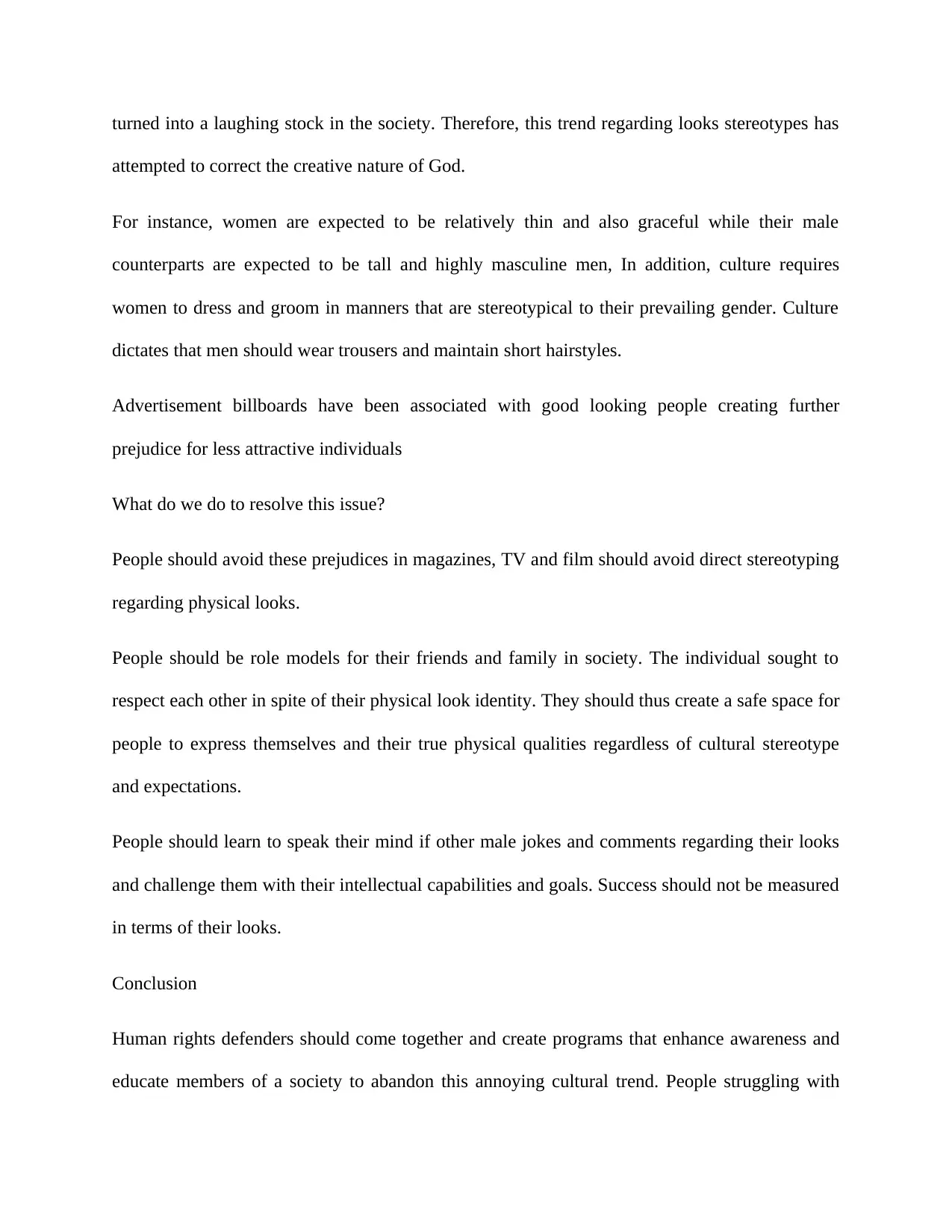
turned into a laughing stock in the society. Therefore, this trend regarding looks stereotypes has
attempted to correct the creative nature of God.
For instance, women are expected to be relatively thin and also graceful while their male
counterparts are expected to be tall and highly masculine men, In addition, culture requires
women to dress and groom in manners that are stereotypical to their prevailing gender. Culture
dictates that men should wear trousers and maintain short hairstyles.
Advertisement billboards have been associated with good looking people creating further
prejudice for less attractive individuals
What do we do to resolve this issue?
People should avoid these prejudices in magazines, TV and film should avoid direct stereotyping
regarding physical looks.
People should be role models for their friends and family in society. The individual sought to
respect each other in spite of their physical look identity. They should thus create a safe space for
people to express themselves and their true physical qualities regardless of cultural stereotype
and expectations.
People should learn to speak their mind if other male jokes and comments regarding their looks
and challenge them with their intellectual capabilities and goals. Success should not be measured
in terms of their looks.
Conclusion
Human rights defenders should come together and create programs that enhance awareness and
educate members of a society to abandon this annoying cultural trend. People struggling with
attempted to correct the creative nature of God.
For instance, women are expected to be relatively thin and also graceful while their male
counterparts are expected to be tall and highly masculine men, In addition, culture requires
women to dress and groom in manners that are stereotypical to their prevailing gender. Culture
dictates that men should wear trousers and maintain short hairstyles.
Advertisement billboards have been associated with good looking people creating further
prejudice for less attractive individuals
What do we do to resolve this issue?
People should avoid these prejudices in magazines, TV and film should avoid direct stereotyping
regarding physical looks.
People should be role models for their friends and family in society. The individual sought to
respect each other in spite of their physical look identity. They should thus create a safe space for
people to express themselves and their true physical qualities regardless of cultural stereotype
and expectations.
People should learn to speak their mind if other male jokes and comments regarding their looks
and challenge them with their intellectual capabilities and goals. Success should not be measured
in terms of their looks.
Conclusion
Human rights defenders should come together and create programs that enhance awareness and
educate members of a society to abandon this annoying cultural trend. People struggling with
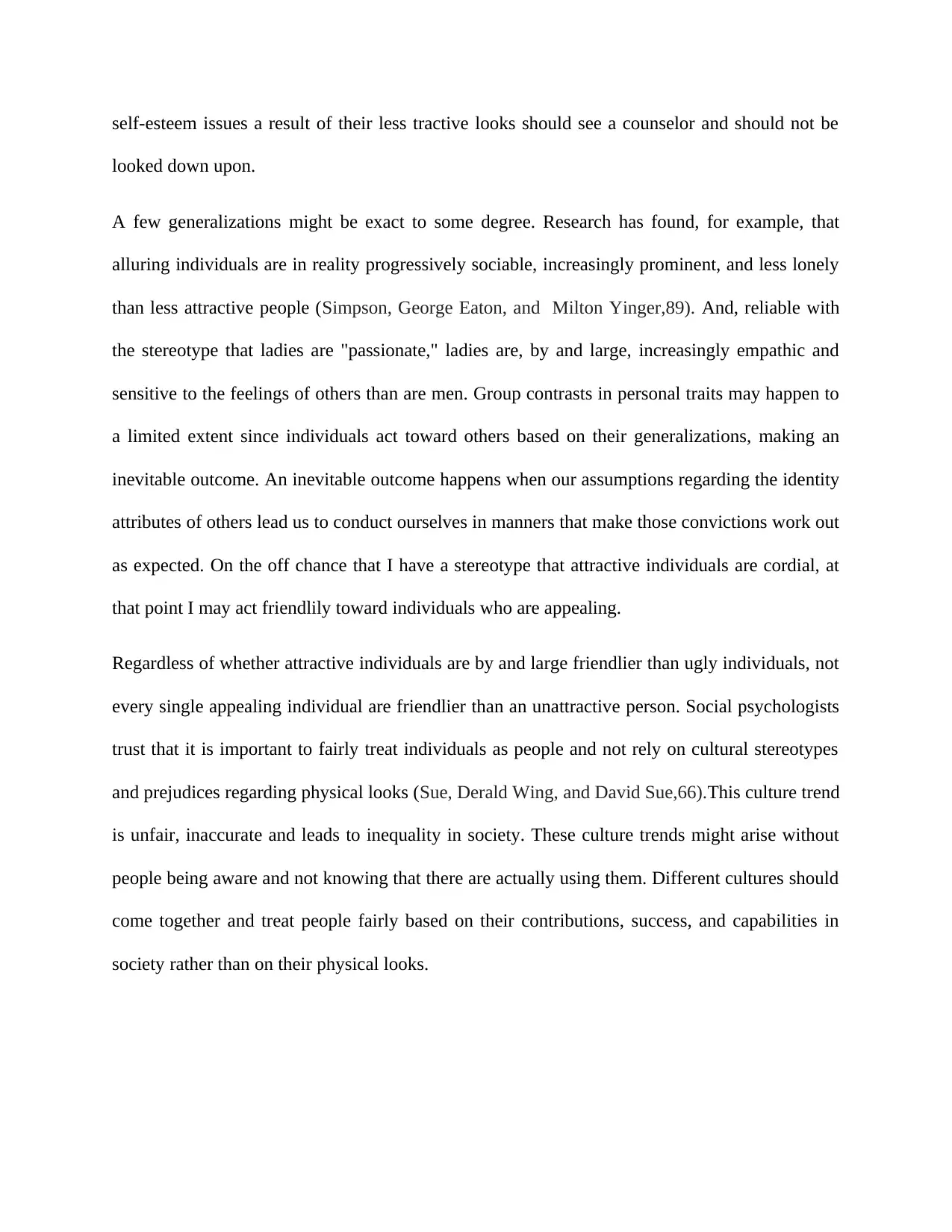
self-esteem issues a result of their less tractive looks should see a counselor and should not be
looked down upon.
A few generalizations might be exact to some degree. Research has found, for example, that
alluring individuals are in reality progressively sociable, increasingly prominent, and less lonely
than less attractive people (Simpson, George Eaton, and Milton Yinger,89). And, reliable with
the stereotype that ladies are "passionate," ladies are, by and large, increasingly empathic and
sensitive to the feelings of others than are men. Group contrasts in personal traits may happen to
a limited extent since individuals act toward others based on their generalizations, making an
inevitable outcome. An inevitable outcome happens when our assumptions regarding the identity
attributes of others lead us to conduct ourselves in manners that make those convictions work out
as expected. On the off chance that I have a stereotype that attractive individuals are cordial, at
that point I may act friendlily toward individuals who are appealing.
Regardless of whether attractive individuals are by and large friendlier than ugly individuals, not
every single appealing individual are friendlier than an unattractive person. Social psychologists
trust that it is important to fairly treat individuals as people and not rely on cultural stereotypes
and prejudices regarding physical looks (Sue, Derald Wing, and David Sue,66).This culture trend
is unfair, inaccurate and leads to inequality in society. These culture trends might arise without
people being aware and not knowing that there are actually using them. Different cultures should
come together and treat people fairly based on their contributions, success, and capabilities in
society rather than on their physical looks.
looked down upon.
A few generalizations might be exact to some degree. Research has found, for example, that
alluring individuals are in reality progressively sociable, increasingly prominent, and less lonely
than less attractive people (Simpson, George Eaton, and Milton Yinger,89). And, reliable with
the stereotype that ladies are "passionate," ladies are, by and large, increasingly empathic and
sensitive to the feelings of others than are men. Group contrasts in personal traits may happen to
a limited extent since individuals act toward others based on their generalizations, making an
inevitable outcome. An inevitable outcome happens when our assumptions regarding the identity
attributes of others lead us to conduct ourselves in manners that make those convictions work out
as expected. On the off chance that I have a stereotype that attractive individuals are cordial, at
that point I may act friendlily toward individuals who are appealing.
Regardless of whether attractive individuals are by and large friendlier than ugly individuals, not
every single appealing individual are friendlier than an unattractive person. Social psychologists
trust that it is important to fairly treat individuals as people and not rely on cultural stereotypes
and prejudices regarding physical looks (Sue, Derald Wing, and David Sue,66).This culture trend
is unfair, inaccurate and leads to inequality in society. These culture trends might arise without
people being aware and not knowing that there are actually using them. Different cultures should
come together and treat people fairly based on their contributions, success, and capabilities in
society rather than on their physical looks.
⊘ This is a preview!⊘
Do you want full access?
Subscribe today to unlock all pages.

Trusted by 1+ million students worldwide
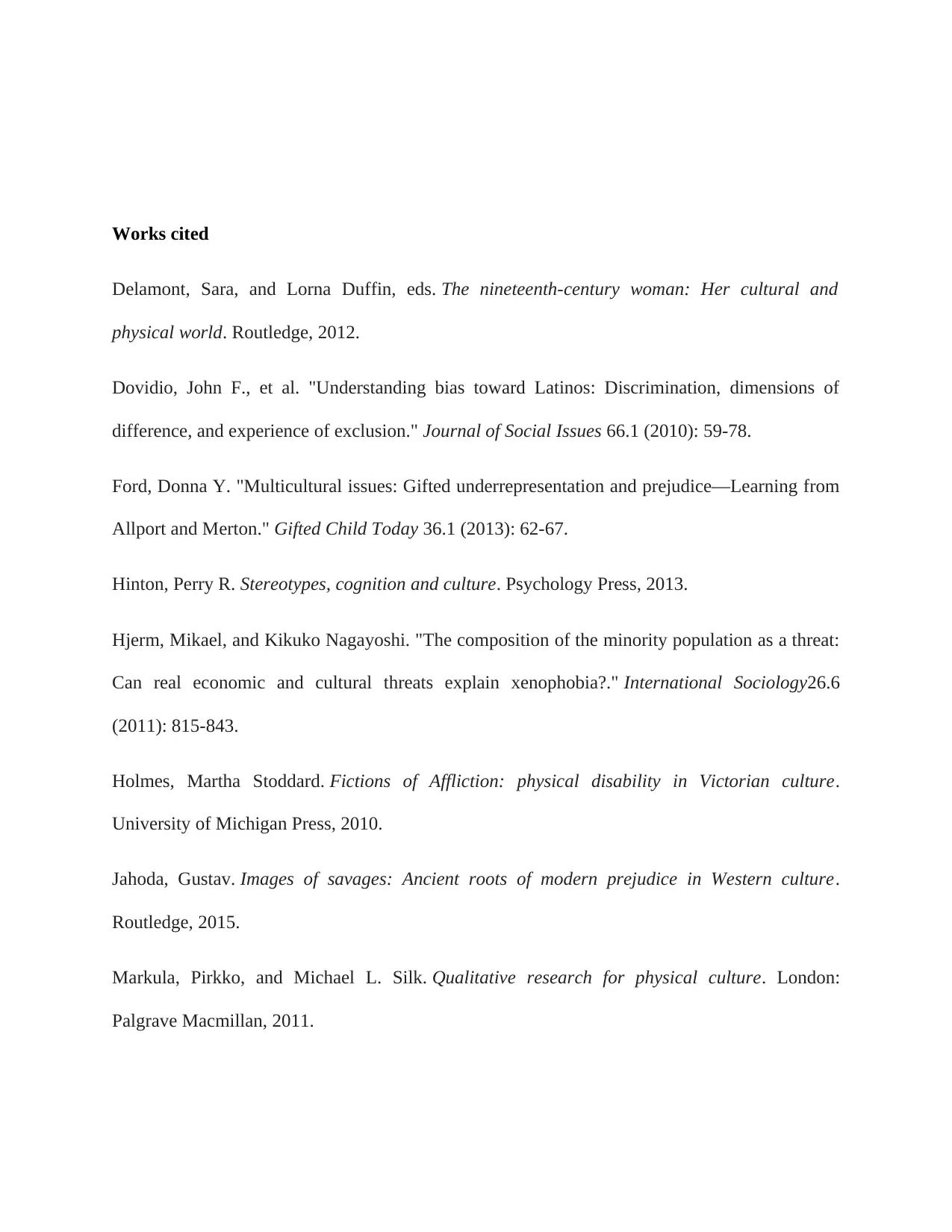
Works cited
Delamont, Sara, and Lorna Duffin, eds. The nineteenth-century woman: Her cultural and
physical world. Routledge, 2012.
Dovidio, John F., et al. "Understanding bias toward Latinos: Discrimination, dimensions of
difference, and experience of exclusion." Journal of Social Issues 66.1 (2010): 59-78.
Ford, Donna Y. "Multicultural issues: Gifted underrepresentation and prejudice—Learning from
Allport and Merton." Gifted Child Today 36.1 (2013): 62-67.
Hinton, Perry R. Stereotypes, cognition and culture. Psychology Press, 2013.
Hjerm, Mikael, and Kikuko Nagayoshi. "The composition of the minority population as a threat:
Can real economic and cultural threats explain xenophobia?." International Sociology26.6
(2011): 815-843.
Holmes, Martha Stoddard. Fictions of Affliction: physical disability in Victorian culture.
University of Michigan Press, 2010.
Jahoda, Gustav. Images of savages: Ancient roots of modern prejudice in Western culture.
Routledge, 2015.
Markula, Pirkko, and Michael L. Silk. Qualitative research for physical culture. London:
Palgrave Macmillan, 2011.
Delamont, Sara, and Lorna Duffin, eds. The nineteenth-century woman: Her cultural and
physical world. Routledge, 2012.
Dovidio, John F., et al. "Understanding bias toward Latinos: Discrimination, dimensions of
difference, and experience of exclusion." Journal of Social Issues 66.1 (2010): 59-78.
Ford, Donna Y. "Multicultural issues: Gifted underrepresentation and prejudice—Learning from
Allport and Merton." Gifted Child Today 36.1 (2013): 62-67.
Hinton, Perry R. Stereotypes, cognition and culture. Psychology Press, 2013.
Hjerm, Mikael, and Kikuko Nagayoshi. "The composition of the minority population as a threat:
Can real economic and cultural threats explain xenophobia?." International Sociology26.6
(2011): 815-843.
Holmes, Martha Stoddard. Fictions of Affliction: physical disability in Victorian culture.
University of Michigan Press, 2010.
Jahoda, Gustav. Images of savages: Ancient roots of modern prejudice in Western culture.
Routledge, 2015.
Markula, Pirkko, and Michael L. Silk. Qualitative research for physical culture. London:
Palgrave Macmillan, 2011.
Paraphrase This Document
Need a fresh take? Get an instant paraphrase of this document with our AI Paraphraser
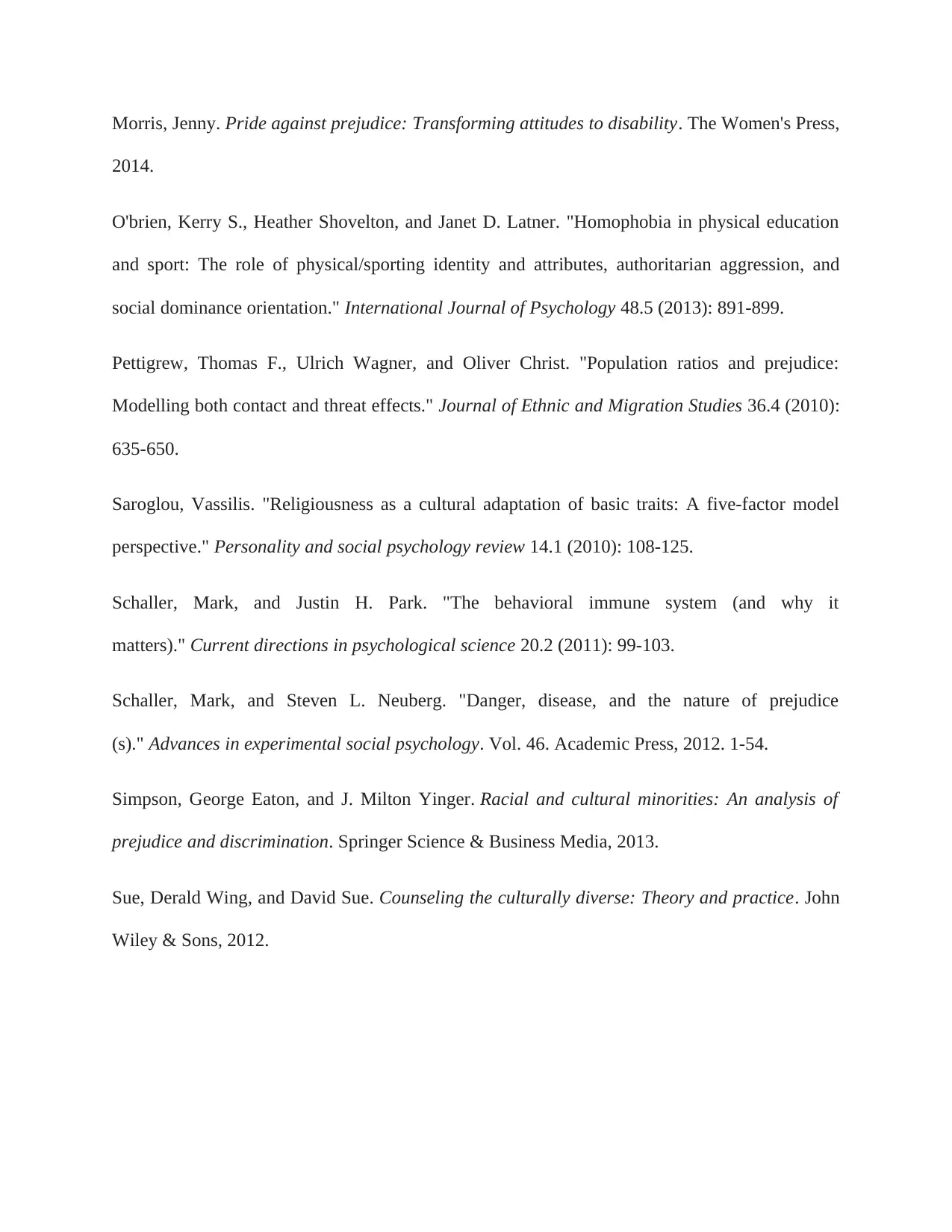
Morris, Jenny. Pride against prejudice: Transforming attitudes to disability. The Women's Press,
2014.
O'brien, Kerry S., Heather Shovelton, and Janet D. Latner. "Homophobia in physical education
and sport: The role of physical/sporting identity and attributes, authoritarian aggression, and
social dominance orientation." International Journal of Psychology 48.5 (2013): 891-899.
Pettigrew, Thomas F., Ulrich Wagner, and Oliver Christ. "Population ratios and prejudice:
Modelling both contact and threat effects." Journal of Ethnic and Migration Studies 36.4 (2010):
635-650.
Saroglou, Vassilis. "Religiousness as a cultural adaptation of basic traits: A five-factor model
perspective." Personality and social psychology review 14.1 (2010): 108-125.
Schaller, Mark, and Justin H. Park. "The behavioral immune system (and why it
matters)." Current directions in psychological science 20.2 (2011): 99-103.
Schaller, Mark, and Steven L. Neuberg. "Danger, disease, and the nature of prejudice
(s)." Advances in experimental social psychology. Vol. 46. Academic Press, 2012. 1-54.
Simpson, George Eaton, and J. Milton Yinger. Racial and cultural minorities: An analysis of
prejudice and discrimination. Springer Science & Business Media, 2013.
Sue, Derald Wing, and David Sue. Counseling the culturally diverse: Theory and practice. John
Wiley & Sons, 2012.
2014.
O'brien, Kerry S., Heather Shovelton, and Janet D. Latner. "Homophobia in physical education
and sport: The role of physical/sporting identity and attributes, authoritarian aggression, and
social dominance orientation." International Journal of Psychology 48.5 (2013): 891-899.
Pettigrew, Thomas F., Ulrich Wagner, and Oliver Christ. "Population ratios and prejudice:
Modelling both contact and threat effects." Journal of Ethnic and Migration Studies 36.4 (2010):
635-650.
Saroglou, Vassilis. "Religiousness as a cultural adaptation of basic traits: A five-factor model
perspective." Personality and social psychology review 14.1 (2010): 108-125.
Schaller, Mark, and Justin H. Park. "The behavioral immune system (and why it
matters)." Current directions in psychological science 20.2 (2011): 99-103.
Schaller, Mark, and Steven L. Neuberg. "Danger, disease, and the nature of prejudice
(s)." Advances in experimental social psychology. Vol. 46. Academic Press, 2012. 1-54.
Simpson, George Eaton, and J. Milton Yinger. Racial and cultural minorities: An analysis of
prejudice and discrimination. Springer Science & Business Media, 2013.
Sue, Derald Wing, and David Sue. Counseling the culturally diverse: Theory and practice. John
Wiley & Sons, 2012.
1 out of 11
Related Documents
Your All-in-One AI-Powered Toolkit for Academic Success.
+13062052269
info@desklib.com
Available 24*7 on WhatsApp / Email
![[object Object]](/_next/static/media/star-bottom.7253800d.svg)
Unlock your academic potential
Copyright © 2020–2025 A2Z Services. All Rights Reserved. Developed and managed by ZUCOL.





